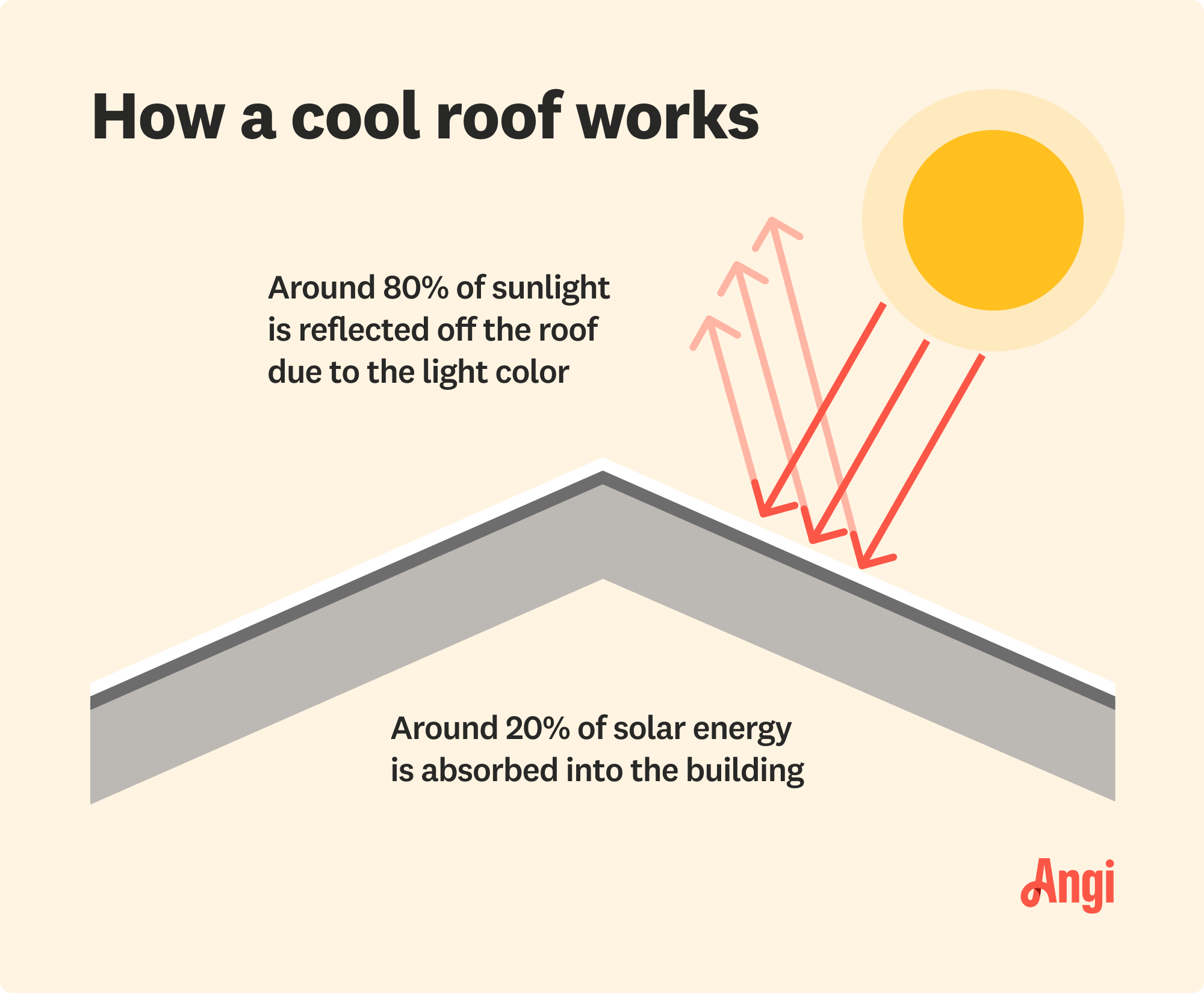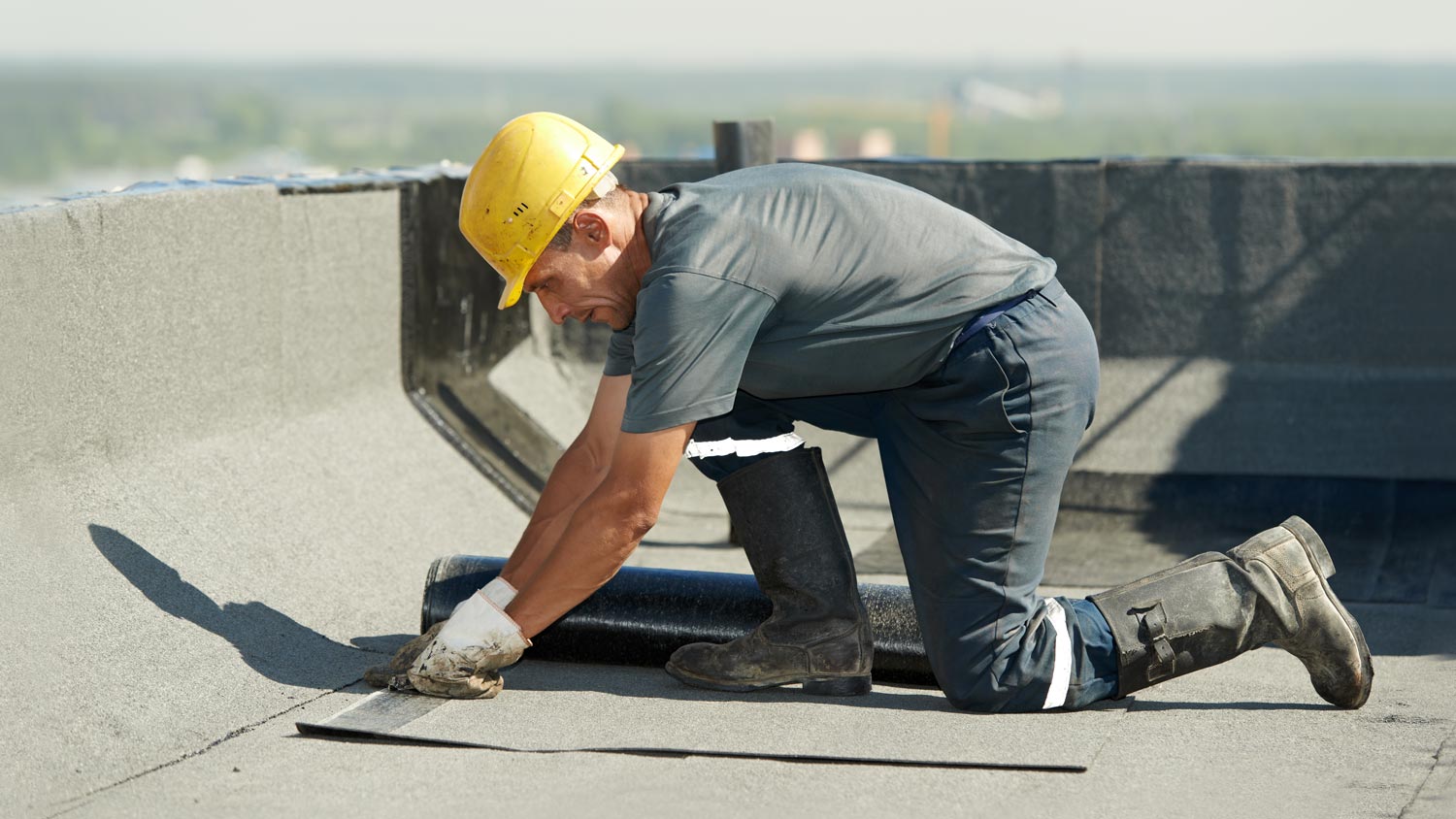What Are Cool Roofs and Are They Worth It?
Don’t let your home feel like Dante’s inferno


Cool roofs reflect solar heat away from your home.
Some cool roofs keep your roof 55 degrees cooler than traditional roofs.
Adding a cool roof coating to an existing roof costs $0.15 to $2.50 per square foot.
Applying a cool roof membrane costs around $1.50 to $3 per square foot.
Some cool roofing materials are eligible for tax savings.
You can convert your roof into a cool one by adding a light or white coating.
It’s not all sunshine and beach vibes when summer comes around—it’s also a time when your roof is put to the test. A hot, traditional roof will bake under the sweltering heat, also putting a strain on your air conditioning.
While proper roof ventilation is an extremely effective way to increase energy efficiency, there is another trick to save energy—cool roofs. Highly reflective cool roofs can help your AC operate more efficiently—and may even qualify for tax incentives.
What Is a Cool Roof?
Cool roofs—also called highly reflective roofs—are light-colored or white roofs that bounce the sun’s heat back to the sky rather than transferring it to your home’s interior, making them more energy-efficient.
Energy-efficient cool roofs can save you money on your energy bills by keeping heat away from the exterior of your house, thus preventing it from seeping in through the attic. While your AC can blast cool air throughout the house to keep temperatures low, a cool roof decreases your dependence on the AC.
"A lighter colored roof or a metal roof with reflective pigment will help reduce summer heat gain, reducing air conditioning loads in the structure."
— Todd Miller, President of Isaiah Industries, Piqua, OH
How Does a Cool Roof Work?
On a hot day, the last thing you’re going to wear is a dark-colored shirt and pants. This is because dark colors absorb more heat than lighter colors. That’s true whether you’re wearing a black T-shirt or your roof is clad in dark-colored shingles.
Cool roofs reflect solar energy with lighter colors and reflective engineering. The lighter the roof color, the less heat it absorbs on a hot, sunny day—and the less your AC works overtime.

How Is Energy-Efficiency Calculated?
The Cool Roof Rating Council rates roofs based on their energy efficiency. Two basic characteristics determine a roof’s coolness:
Solar reflectance (SR): Measures how much sunlight a surface reflects
Thermal emittance (TE): Refers to a material’s ability to release absorbed heat
Both characteristics are rated on a scale from zero to one, where one is the most reflective or emissive, and zero is the most heat-absorbent. In other words, the higher the numbers, the cooler the roof.
Lighter colors reflect the most heat. However, with new materials and products on the market, you can choose from cool colors or darker roofing materials treated with coatings, granules, paint, etc.
Types of Cool Roof Materials
The U.S. Department of Energy defines cool roofs as roofs that are more reflective than conventional roofing. Some popular cool roof materials include:
| Roofing Material | Cost (per Sq. Ft.) |
|---|---|
| Asphalt shingles | $0.70–$4 |
| Metal shingles | $4–$30 |
| Wood shakes | $4–$6 |
| Terra cotta | $5–$10 |
| Concrete | $2–$4 |
Some of these materials, like metal, asphalt, concrete, and darker clay, must be coated with a lighter polymer coating to turn it into a cool roof.
Types of Cool Roof Coatings

If you recently installed a darker roof, don’t worry—you can still convert your roof into a cool one with a cool roof reflective coating like these:
White roof coating: Your roof will glimmer like a pearl with a white coating. All that shine is actually the sun beaming off your roof rather than into your roof. White roof coatings can reflect as much as 80% of the sun’s rays.
Pigmented coating: Some homeowners don’t want a white roof but do want the benefits of a cool roof coating. The pigmented coating offers some solar reflectance and more color options, like hues of red, blue, or green, but it might only reflect 20% of solar heat.
Aluminum coating: This coating uses aluminum flakes in a resin to cover hot asphalt. The material reflects 50% to 70% of solar heat.
Reflective granulated cap sheet: Cap sheets contain layers of asphalt or tar-coated fiberglass matting. To make it a cool roofing material, a reflective coating or a surface made from reflective mineral granules is applied to the top layer.
Roof membrane: There are three types of roofing membranes, including Ethylene Propylene Diene Monomer (EPDM), thermoplastic polyolefin (TPO), and polyvinyl chloride (PVC). These single-ply plastic sheets go on top of the roofing to protect the roof and reflect solar heat. TPO roofing costs between $6,800 and $21,000 to install.
Polyurethane foam spray: You can also use spray foam to protect your roof, but this option requires an additional protective coating to prevent sun and moisture damage.
Conventional Roofs vs. Cool Roofs
Traditional dark roof shingles absorb more sunlight and heat both the building and the surrounding air, thus giving them lower SR and TE ratios than cool roofs. A conventional roof can get as hot as 150 degrees F or greater during peak summer hours of intense sunlight.
A reflective roof coating can change this significantly.
The Berkeley Lab estimates that, on a typical summer afternoon, a clean, well-maintained white-coated roof that reflects 80% of the sunlight that hits it will stay about 55 degrees cooler than a traditional dark roof that reflects just 20% of that sunlight.
Pros and Cons of Cool Roofing
Before you decide on a cool roof, it’s helpful to know how this type of energy-efficient roof benefits your home—and also how it might not be a good fit for you. Here are the pros and cons of choosing a cool roof.
Benefits of a Cool Roof
A cool roof can benefit your home in many ways:
Keeps your home more comfortable during the hottest months
Lowers energy bills
Reduces the need for the AC, helping to prolong your equipment
Decreases your roof’s temperature, potentially extending its life
Lowers air pollution by reducing electricity use
Reflects heat into the air, keeping urban areas cooler
May be eligible for tax savings
Disadvantages of a Cool Roof
It costs more than traditional roofing
It could be aesthetically displeasing for some homeowners
Like white kitchen floors or a white car, cool roofs can look dirty faster than dark roofs
Algae show up much clearer on a light or white roof
May keep your house too cold in the winter
For homes in a warm or hot climate, it makes sense to invest in a cool roof, but for homes in a temperate or cold climate, it might actually cost you more to heat your home come wintertime.
How Much Does a Cool Roof Cost?
Applying a cool roof coating to an existing roof will cost around $0.15 to $2.50 per square foot, while applying a single-ply cool roof membrane will cost you more—around $1.50 to $3 per square foot. Expect to pay a premium for a colored cool roof, as the added cooling pigments they require cost more.
When calculating the cost to install a cool roof, the installation can fall anywhere between $0.25 and $3 per square foot. EPDM, PVC, and TPOs cost the most, while liquid coating costs the least. You can reduce your AC’s energy use by 15% if you live in a single-story home, according to the Environmental and Energy Study Institute (EESI). Two-story homes contain more heat because heat rises (also called the stack effect) making savings a little lower.
When to Install a Cool Roof
It’s important to plan a new roof installation or a cool roof coating. Many homeowners are practically itching to get a new cool roof installed in the spring when winter is over and summer is fast approaching. However, if you live in a rainy climate or one where freezing temperatures last well into spring, you’ll want to wait for the unpredictable weather to pass.
The ideal time to install a roof is when the weather is predictable and it’s not scorching hot and humid outside. This can either be in late spring, late summer, or early fall. The downside of choosing late summer and early fall is that this period is in high demand, meaning prices tend to be more competitive and availability more limited.
DIY or Hire a Pro to Install a Cool Roof
Before you run to the hardware store and get on the roof to apply a cool coating yourself, you should consider hiring a roofer near you to do the job. Your climate, roof’s slope, and budget determine which material will be the most energy-efficient for your home, and you don’t want to make a mistake that could cost you big time in the long run—or risk injury on the roof.
A roofing pro in your area is familiar with the climate, the local roof styles, and cool roof best practices and can safely install or apply cool roofing for you.
Frequently Asked Questions
Cool roofs last for roughly 15 to 30 years. You can install a cool roof coating over an existing roof, but keep in mind that this might not be worth it if your roof is near the end of its life expectancy. If your roof isn’t near the end of its life, adding a cool roof coating can make your existing roof more energy-efficient and help it last longer, so you’ll have to weigh the pros and cons.
A cool roof is any heat-reflecting roof that rejects solar energy more efficiently than traditional roofing (staying about 50 degrees cooler). Thanks to this ability, a cool roof will make your home cooler on a hot, sunny day. Cool roofs come in a variety of materials, including asphalt, wood, or polymer shingles, clay or concrete tiles, metal, and more.
A cool roof can be worth it in the right climate. Cool roofs are excellent at reflecting solar heat away from your home, so if you live in a warm or hot climate, they can be a great roofing choice. Some cool roofing materials are even eligible for tax credits. However, they cost more than traditional roofing and don’t retain heat as well as traditional roofing, so they’re not ideal if you live in a cold climate.
No, cool roofs are not suitable for all climates. Cool roofs are very good at reflecting solar heat, so they’re suitable for homes in warm or hot climates. However, they’re not good at retaining heat, so they’re not suitable for homes in cold climates.





- Roofers
- Metal Roofing
- Roof Repair
- Roof Inspection
- Vinyl Siding Repair Contractors
- Flat Roofing Companies
- Commercial Roofing
- Emergency Roofing Companies
- Leaky Roof Repair
- Metal Roof Repair
- Business Roof Repair
- Flat Roof Repair
- Tile Roof Repair
- Slate Roofers
- Rubber Roofers
- Roofing & Siding
- Metal Roof Installation
- Affordable Roofing
- Roof Sealing
- Attic Ventilation Contractors
- 6 Benefits of Energy-Efficient Roofs
- Energy-Efficient Roofing: Here’s What to Know
- How to Choose the Best Color for Your Metal Roof
- Does Roof Shingle Color Improve Energy Efficiency?
- 9 Warning Signs You Need a New Roof
- Explore the Pros and Cons of Roof Cleaning
- Hot Roof vs. Cold Roof: What’s the Difference?
- 9 Ways to Help Your Roof Last Longer
- Roof Painting: Everything to Know About Painting Your Home’s Roof
- 2024 Metal Roof vs. Shingles Cost Comparison Guide











